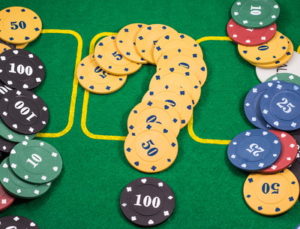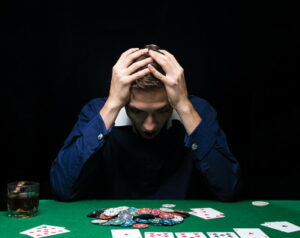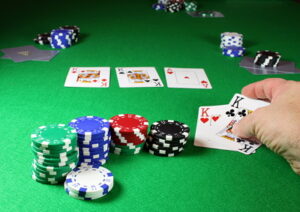 One of the best draws in Hold’em poker is obviously the quads draw (or four of a kind). Quads rank just behind the most valuable hand – a straight flush – and the game is more spectacular when a player hits quads and tries to get the maximum from their hand.
One of the best draws in Hold’em poker is obviously the quads draw (or four of a kind). Quads rank just behind the most valuable hand – a straight flush – and the game is more spectacular when a player hits quads and tries to get the maximum from their hand.
When two players hit quads by river, their fight delights the audience and the players themselves; it’s an exciting poker experience, for both the winner and the loser.
In this article we shall see what are the odds of two players hitting quads by river and what are the circumstances for that event to happen.
When Is The Board Favourable For Double Quads
 If two players hit quads by river, those quads will, of course, be of a different rank. But how could the board be configured at the river stage so that two quads draws are possible in the same round?
If two players hit quads by river, those quads will, of course, be of a different rank. But how could the board be configured at the river stage so that two quads draws are possible in the same round?
There are two general possibilities: The board is either paired with a rank and tripled with the other rank, formally CCCDD, or is double paired, formally CCDDX. (C and D are the two different ranks, and X is an arbitrary rank different from C and D – for instance 888JJ in the former case and 9977K in the latter case.)
Let’s see now what are the odds for such configurations to occur on the board. We will calculate them in the moment before any card is dealt, with no information available about the hole cards. There are C(52,5) = 519,792 possible configurations for the board, regardless of the deals.
For two specific ranks C and D, there are C(4,3) x C(4,2) = 24 combinations of the form CCCDD and C(4,2) x C(4,2) x (52 – 8) = 1,584 combinations of the form CCDDX.
We have to multiply these results by C(13,2) = 78, the number of ways we can choose two ranks from all 13. Then, the probabilities are:
- P(CCCDD)= 24 x 78 / 519,792 = 0.0036 = 0.36%
- P(CCDDX) = 1,584 x 78 / 519,792 = 0.2376 = 23.76%
In total, there is about a 24% chance of having a river board favourable for a double quads draw. In frequency terms, such configurations happen in average once in about every 4.2 games.
These may seem high odds, but this does not mean that any quads are hit easily.
Odds For Two Players Hitting Quads By River
 If the river board has any of the configurations described in the previous section, let’s see what are the odds of one or more players hitting quads, from a neutral perspective (not taking into account any pocket cards).
If the river board has any of the configurations described in the previous section, let’s see what are the odds of one or more players hitting quads, from a neutral perspective (not taking into account any pocket cards).
First, take the CCCDD board. The probability for a specific player to hold a C-card is 46/C(47,2) = 46/1,081 = 0.0425. We get the probability that any of the players holds a C-card by multiplying 0.0425 with the number of players (only one player may hold such a card). The odds are given in the table below:
Probability that any of the players hits the quads with the triple on the board
| No. of players | Probability |
|---|---|
| 2 | 0.085 = 8.5% |
| 3 | 0.1275 = 12.75% |
| 4 | 0.17 = 17% |
| 5 | 0.2125 = 21.25% |
| 6 | 0.255 = 25.5% |
| 7 | 0.2975 = 29.75% |
| 8 | 0.34 = 34% |
| 9 | 0.3825 = 38.25% |
| 10 | 0.425 = 42.5% |
Table 1.
The probability for a specific player to hold a DD pair is 1/C(47,2) = 1/1,081 = 0.00092 = 0.09%. Like above, the probability that any of the players hold a DD pair depends on the number of players, as in the next table:
Probability that any of the players hits the quads with the pair on the board
| No. of players | Probability |
|---|---|
| 2 | 0.00184 = 0.18% |
| 3 | 0.00276 = 0.27% |
| 4 | 0.00368 = 0.36% |
| 5 | 0.0046 = 0.46% |
| 6 | 0.00552 = 0.55% |
| 7 | 0.00644 = 0.64% |
| 8 | 0.00736 = 0.73% |
| 9 | 0.00828 = 0.82% |
| 10 | 0.0092 = 0.92% |
Table 2.
Now, the probability that two specific players hit the quads draw (CCCC and DDDD) is (44/C(47,2)) x (1/C(45, 2)) and for n players in play, the probability that any two players hit the quads is C(n,2) x (44/C(47,2)) x (1/C(45, 2)). This formula returns the following values:
Probability that any two players hit the quads with the board CCCDD
| No. of players | Probability |
|---|---|
| 2 | 0.0000411 = 0.0041% |
| 3 | 0.0001233 = 0.012% |
| 4 | 0.0002466 = 0.025% |
| 5 | 0.0004110 = 0.041% |
| 6 | 0.0006165 = 0.062% |
| 7 | 0.0008631 = 0.086% |
| 8 | 0.0011508 = 0.115% |
| 9 | 0.0014796 = 0.148% |
| 10 | 0.0018499 = 0.185% |
Table 3.
Take now the CCDDX board. The probability for a specific player to hold a CC pair is 1/C(47,2) = 1/1081 = 0.00092 = 0.09%. The same probability stands for the DD pair. The probability for a specific player to hit the quads draw is then 0.184%. The odds for at least one player (one or two) to hit quads are given in the next table:
Probability that at least one player hits the quads with either pair on the board
| No. of players | Probability |
|---|---|
| 2 | 0.003679 = 0.36% |
| 3 | 0.005519 = 0.55% |
| 4 | 0.007359 = 0.73% |
| 5 | 0.009199 = 0.91% |
| 6 | 0.011039 = 1.10% |
| 7 | 0.012879 = 1.28% |
| 8 | 0.014719 = 1.47% |
| 9 | 0.016559 = 1.65% |
| 10 | 0.018399 = 1.83% |
Table 4.
The probability that two specific players hit the quads draw is (1/C(47,2)) x (1/C(45, 2)) and for n players in play, the probability that any two players hit the quads is C(n,2) x (1/C(47,2)) x (1/C(45, 2)). This formula returns the following values:
Probability that any two players hit the quads with the board CCDDX
| No. of players | Probability |
|---|---|
| 2 | 0.000000934 = 0.000093% |
| 3 | 0.000002802 = 0.00028% |
| 4 | 0.000005604 = 0.00056% |
| 5 | 0.000009340 = 0.00093% |
| 6 | 0.000014010 = 00014% |
| 7 | 0.000019614 = 0.0020% |
| 8 | 0.000026152 = 0.0026% |
| 9 | 0.000033624 = 0.0034% |
| 10 | 0.000042030 = 0.0042% |
Table 5.
Let’s draw a brief conclusion of what we have found thus far.
The chances for the board configuration to permit a double quads draw are not low at all (24%). In that situation the odds for any player to hit the quads are relatively high (31 – 44% for the tripled board and between 1.3 – 1.8% for the double paired board, for more than six players active), however the odds for any two players hitting quads are extremely low.
These odds get even lower if we want them computed in a moment before the river (In the preflop stage, they have to be multiplied by those 24% for the board to get favourable for the double quads draw).
But let’s see how these odds change with the information given by your own hole cards, if you find yourself in the position of hitting quads by river with a board like that discussed.
Your Quads Against Your Opponents’ Possible Quads
 If you are lucky enough to be in the position to have quads by river and the board is of the form CCCDD or CCDDX, let’s see what are the odds for one of yours opponents to have quads, too.
If you are lucky enough to be in the position to have quads by river and the board is of the form CCCDD or CCDDX, let’s see what are the odds for one of yours opponents to have quads, too.
The first case to consider is the board CCCDD with your hole cards unpaired and including a C-card.
The odds for one opponent to have DD is 1/C(45,2) = 1/990 and the odds that any of your opponents have DD are in the next table:
Probability that any of your opponents has quads with the CCCDD board against your CCCC quads
| No. of opponents | Probability |
|---|---|
| 1 | 0.00101 = 0.101% |
| 2 | 0.00202 = 0.202% |
| 3 | 0.00303 = 0.303% |
| 4 | 0.00404 = 0.404% |
| 5 | 0.00505 = 0.505% |
| 6 | 0.00606 = 0.606% |
| 7 | 0.00707 = 0.707% |
| 8 | 0.00808 = 0.808% |
| 9 | 0.00909 = 0.909% |
Table 6.
Any probability here is under 1%. You may push all in. If an opponent raises it is very likely that either they have a full house and they underestimate your odds of having quads or they bluff (straight flush for them is not possible in this configuration).
The next case is with the same board and with your hole cards DD paired. In this case the odds change dramatically: The probability for one opponent to have a C-card is 44/C(45,2) = 44/990 = 0.0444 = 4.44% and increase linearly with the number of your opponents:
Probability that any of your opponents has quads with the CCCDD board against your DDDD quads
| No. of opponents | Probability |
|---|---|
| 1 | 0.0444 = 4.44% |
| 2 | 0.0888 = 8.88% |
| 3 | 0.1332 = 13.32% |
| 4 | 0.1776 = 17.76% |
| 5 | 0.222 = 22.20% |
| 6 | 0.2664 = 26.64% |
| 7 | 0.3108 = 31.08% |
| 8 | 0.3552 = 35.52% |
| 9 | 0.3996 = 39.96% |
Table 7.
From five opponents up, the chances that one may have quads are relatively high. If in this situation one opponent is aggressive or sticks to you, you should consider that they have hit quads, too. However, if your quads ranks higher (D > C, and you know that) you should have no worry, not mentioning that straight flush is not possible here.
The last case to consider is with the CCDDX board. If you have quads, the odds that your opponents have quads are the same as in the first case above and the results in Table 6 apply.
One thing that makes Texas Hold’em the most popular version of poker is that the odds of any draw change significantly with every new card dealt on the board. The quads versus quads odds are a good example on how important is the information available when we compute Hold’em odds and how the strength of your hand can be assessed only based on probability.
About The Author
The author of this page is Dr. Catalin Barboianu. Catalin is a mathematician specialising in gaming and responsible gambling and a research associate at the University of Bucharest.
